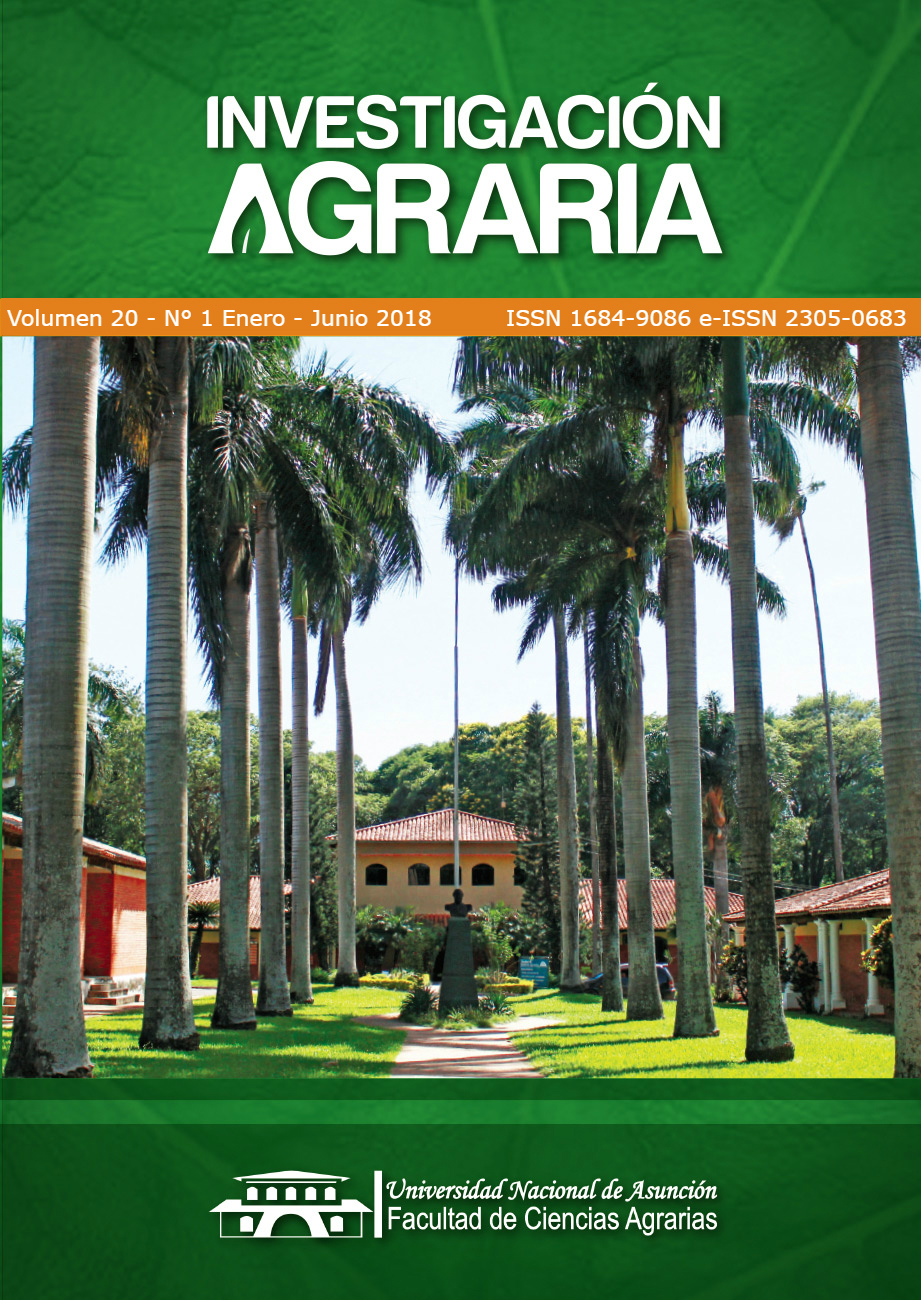Effects of five planting density on pea lines Pisum sativum L. with the mutant gene afila
DOI:
https://doi.org/10.18004/investig.agrar.2018.junio.22-29%20%20Keywords:
Plant architecture, population density, plant breeding, promising linesAbstract
The objective of this research was to evaluate the effect of five planting densities on the agronomic behavior of five lines of pea Pisum sativum L. modified with the mutant gene afila (af). This research was developed in the department of Nariño, Colombia. For the statistical analysis, an experimental design of complete random blocks was used, with divided plots and three replicates. The main plot corresponded to the lines with gene af and the subplots at the densities D1: 100.000, D2: 200.000, D3: 50.000, D4: 83.333 and D5: 166.666 plants per hectare. Statistical differences were presented for the effect of density on the number of pods per plant and yield; for the effect of the genotype there were no statistical differences, only for the variable, relationship grain/pod. The density of 100.000 plants per hectare was the agronomic adjustment, which allowed to obtain the highest projected yield with 15,81 t ha-1, with respect to the other evaluated densities; in terms of genotypes, the Andina variety and the lines UNIFI4 and UNIFI2 showed the best result for yield and were statistically similar with 13,72; 12,18 and 11,47 t ha-1, respectively.Downloads
Metrics
References
Abi-Ghanem, R; Bodah, ET; Wood, M; Braunwart, K. 2013. Potential breeding for high nitrogen fixation in Pisum sativum L.: germplasm phenotypic characterization and genetic investigation. American Journal of Plant Sciences. 4(8): 1597-1600
AGRONET (Red de Información y Comunicación del Sector Agropecuario de Colombia). 2017. Agronet Min Agricultura. Estadísticas agrícolas: Área, producción, rendimiento y participación. Consultado 16 mayo. 2018. Disponible en http://www.agronet.gov.co/estadistica/Paginas/default.aspx
Ambrose, M. 2007. Garden Pea. In Prohens, J; Nuez, F. (eds.). Vegetables II: Liliaceae, Solanaceae, and Umelliferae. Valencia, España, Springer Science and Bussines Media. p. 3-26. Serie Handbook of plant breeding. Springer.
Burbano E, E; Vallejo Cabrera, FA. 2017. Producción de líneas de tomate “chonto” Solanum lycopersicum Mill., con expresión del gen sp responsable del crecimiento determinado. Revista Colombiana de Ciencias Hortícolas 11(1): 63-71.
Casanova E, L; Solarte L, J; Checa C, O. 2012. Evaluación de cuatro densidades de siembra en siete líneas promisorias de arveja arbustiva (Pisum sativum L.). Revista de Ciencias Agrícolas. 29(2): 129 - 140.
FENALCE (Federación Nacional de Cultivadores de Cereales y Leguminosas, Colombia). 2010. Indicadores sectoriales. (en línea). Consultado 20 Jun. 2015. Disponible en http://www.fenalce.org/nueva/pg.php?pa=19
Forero, AF; Ligarreto, GA. 2009. Evaluación de dos sistemas de tutorado para el cultivo de la arveja voluble (Pisum sativum L.) en condiciones de la Sabana de Bogotá. Revista Colombiana de Ciencias Hortícolas 3(1): 81-94.
González, F; Ligarreto, G. 2006. Rendimiento de ocho genotipos promisorios de arveja arbustiva (Pisum sativum L.) bajo sistema de agricultura protegida. Fitotecnia Colombiana. 6(2):52-61.
IDEAM (Instituto de Hidrología, Meteorología y Estudios Ambientales, Colombia). 2016. Departamento Administrativo de Estadística. IDEAM (en línea, sitio web). Consultado 15 agosto 2016. Disponible en: http://www.ideam.gov.co/web/pronosticos-y-alertas/datos-de-pronostico
Khan, TN; Ramzan, A; Jillani, G; Mehmood, T. 2013. Morphological performance of peas (Pisum sativum) genotypes under rainfed conditions of Potowar region. J. Agric. Res. 51(1): 51-60
Ligarreto, G. 2009. Análisis de parámetros heredables asociados al rendimiento y precocidad en arveja voluble (Pisum sativum L.) tipo Santa Isabel. Agronomía Colombiana, 27(3), 333.
Martin, I; Tenorio, JL; Ayerbe, L. 1994. Yield, Growth, and water use of conventional and semi-leafless peas in semi-arid environments. Crop Sci. 34:1576-1583.
Marx, GA. 1987. A suite of mutants that modify pattern formation in pea leaves. Plant Molecular Biology Reporter 5(3):311 - 335.
Marx, GA; Mishanec, W. 1967. Further Studies on the Inheritance of Ovule Number in Pisum L. Crop Science Abstract 7(3):236-239.
Meadley, JT; Milbourn, GM. 1970. The growth of vining peas. II The effect of density of planting. The Journal of Agricultural Science 74(2): 273-278.
Mera, M. 1989. Densidad poblacional y espaciamiento en arveja (Pisum sativum L.) para grano seco de follaje reducido. Agricultura técnica 49(2):148-152.
Mera, M; Levío, J; Alcalde, J; Morales, M; Galdames, R. 1996. Brisca-INIA, primera variedad de arveja áfila obtenida en Chile. Agricultura técnica 56(4):282-286.
Mihailovic, V. 2008. Componentes de rendimiento de grano afila (af) líneas de guisantes forrajeros (Pisum sativum L.). Instituto de Cultivos y Hortalizas, NoviSad, Serbia. 98 p.
Pantoja, D; Muñoz, K; Checa, O. 2014. Evaluación y correlación de componentes de rendimiento en líneas avanzadas de arveja Pisum sativum L. con gen afila. Revista de Ciencias Agrícolas . 31(2): 24-39
Sañudo, B; Checa, O; Arteaga-Meneses, G. 1999. Manejo agronómico de leguminosas en zonas cerealistas. Pasto, Colombia, Produmedios, p. 97.
SAS. 2016. Statistical Analysis Software. Consultado 10 de febrero. 2016. Disponible en https://www.sas.com/en_us/software/stat.html
Smýkal, P; Coyne, C; Redden, R; Maxted, N. 2013. Peas. In Singh M; Hari D; Bisth, S. Genetic and genomic resources of grain legume improvement. First edition. Elsevier Insights, London. p. 41-80
Tulcán, G; Castillo, C. 1998. Efecto de la labranza y aplicación de herbicidas en el manejo de malezas en el cultivo de arveja (Pisum sativum L.) en el municipio de Pasto departamento de Nariño. Tesis Ingeniero Agrónomo. Universidad de Nariño: Facultad de Ciencias Agrícolas.
Vladan, P; Radisa, D; Pedja, M; Predrag, J. 2013. Influence of the afila gene on grain yield in pea (Pisum sativum L.). African Journal of Agricultural 8(16):1513-1519.
Wang, F; Fu, J; Dong, L; Zhu, Y. 2003. Tendril inheritance in semi-leafless pea and its utilization in breeding. YiChuan. 25(2):8-185.
Downloads
Published
How to Cite
Issue
Section
License
Copyright (c) 2018 Investigación Agraria

This work is licensed under a Creative Commons Attribution 4.0 International License.
All content in this journal is under Creative Commons Attribution License.









 All content in this journal is under
All content in this journal is under 